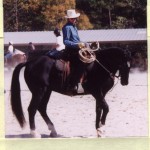 Clear, correct cues are important when you are training any horse but based on a horse temperament you will often get different responses to a cue. Professional horseman understand this but getting different responses to a cue can be confusing for an amateur horseman. Understanding Five Element horse temperament typing can help those of us with less horse experience know better how present our cues and judge our horse’s responses.
Clear, correct cues are important when you are training any horse but based on a horse temperament you will often get different responses to a cue. Professional horseman understand this but getting different responses to a cue can be confusing for an amateur horseman. Understanding Five Element horse temperament typing can help those of us with less horse experience know better how present our cues and judge our horse’s responses.
For example, I was riding a colt at a horsemanship clinic with Tom Curtain and Tom had showed me several times how to shorten my rein and ask for a turn with more authority. This colt was a Wood horse temperament and he was ignoring my cue to turn. Tom rode by and instead of correcting me again he simply said, “that is a pretty piss, poor presentation”. It finally clicked for me that the colt was not going to change his behavior, I had to change mine.
Lets look at how each horse temperament would normally respond to a well presented cue to turn.
Fire horse temperament – A Fire horse is sensitive and usually very willing to please so so a typical reaction to a cue to turn would be prompt and correct. If the Fire horse offered resistance then it would likely be due to not understanding the cue or inability to properly perform it. The Fire horse does not handle pain well so check for poor fitting tack, musculo-skeletal, dental or digestive issues that could generate pain.
Earth horse temperament – An Earth horse is generally willing to please but can be lazy so a typical response to the turn cue would be forthcoming but perhaps done without enthusiasm. For the Earth horse it seems easier to amble along in a straight line rather than rearrange himself to make the turn. You may need to reinforce your cue with a tap from your crop of add some light spur to encourage a more prompt response.
Metal horse temperament – A Metal horse needs lessons spelled out very clearly and learns best from repetition and memorization. You may want to offer your turn cue in the same area of the arena until your Metal horse has made the connection. You can use the fence to help by riding straight toward it and giving your cue as you get close enough that your horse would have to turn on his own. Once a Metal horse understands a cue he will perform the task flawlessly from then on.
Water horse temperament – A Water horse tends to be highly reactive and may have a tendency to over respond to a cue to turn by completely reversing direction or even spinning around 360 degrees. No worries, simply soften your presentation and be ready to release any pressure even as the Water horse thinks about turning. Make sure you stay centered and don’t correct the horse for the over reaction. Remember, it is up to you to change your presentation to fit the horse not the other way around.
Wood horse temperament – A Wood horse gets bored easily and will have a tendency to argue over a simple cue to turn. The best approach is to make the turn the idea of the Wood horse. You can use the fence and ride straight to it and let the horse decide which way he is going to turn and bring your cue in just as he makes his decision. You can also have the Wood horse follow another horse or a cow and give your turn cue as the horse turns on his own. You can also give the Wood horse an obstacle such as a barrel or bush to turn around. The secret is to have the turn cue be part of a job, not simply a boring exercise.
So now when you know the horse temperament you are dealing with you can have some of the same success as a more experienced horseman. To determine your horse’s temperament go to the Horse Harmony Test. Madalyn
For more information about Five Element Horse Temperaments check out Horse Harmony
We also have some Five Element Audios of actual case histories and discussion of each horse temperament type. Real life cases are a great way to gain understanding of Five Element typing.